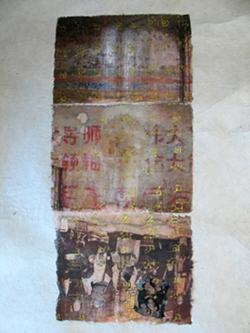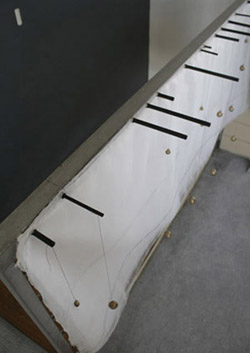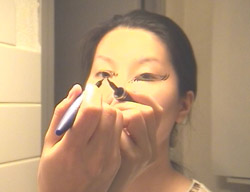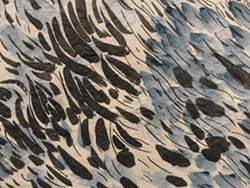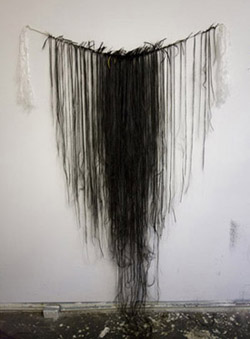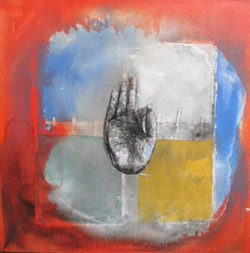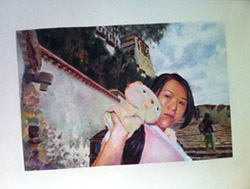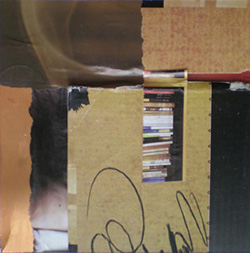Satellite Exhibition
Art as the Mother Tongue:
A Dialogue Between East and West
Winter — Summer, 2011
Art as the Mother Tongue, 1708 Gallery’s latest satellite exhibition at Richmond’s historic Linden Row Inn features works by artists from Australia, China, Ireland and the US. Curated by Richmond artist and 1708 board member Amie Oliver. Art as the Mother Tongue will open on Friday, February 4, 2011 and will be on view through spring 2011. The proceeds from all art sales benefit the artist and the exhibition programs of 1708 Gallery.
Curatorial Statement
This exhibition reflects the assimilation of time, experience and intercultural dialogue between artists from opposite sides of the globe whose communications have relied most readily on the universal language of art. These communiqués became paramount to me during the Metasenta Moving Cultures Project in Tibet and China during 2009 and during a series of exhibitions and exchanges between Korean and Virginian artists begun in 2002. The world gets smaller each day, yet working on the "other side" of the planet can still have a profound affect on the studio practice and the world view of a working artist.
Much of the work in this show was initiated by Metasenta Founder and Director Dr. Irene Barberis' Moving Cultures Project. It was designed to be a multi-cultural, cross-disciplinary research and exhibition collective of people, place and processes situated in the ‘civic space’ of a moving train. Other artists' work grew from a series of Korean and American exchanges organized by Artificum of Humanitas founder Heeja Sung.
As artists assimilate the profound implications and possibilities of relying on art as our mother tongue, we embrace the struggle to communicate as one community in an increasingly complex world. Much of the work in this exhibition was designed to fit in a tube or a small container so that it may travel the globe and offer its maker the opportunity to communicate their experience of our moving culture - one where travel visas, customs and jet lag are only the tip of the iceberg.
This group of artists, from each corner of the planet, shares the common language of art. Some speak a few words of English, others a few works of Chinese or Korean. For others Art is the mother tongue we share... an artist statement in English is often not possible. Their art speaks for itself. Please listen, look and read their work as it is in the global language of art.
This exhibition would not be possible without support from The Po and Helen Chung Foundation, Metasenta's founding benefactor and installation expertise from a Capital One exhibition team led by Francis Thompson.
Amie Oliver
1708 Gallery Satellite Exhibitions Liason and Curator
Exhibiting Artists
Hetty Baiz, Princeton, NJ (mixed media paper)
There are several images/thoughts/ideas that have remained with me from my sojourn to Tibet and inspired my artwork. One was the Chinese characters -- "to the Great Chairman Mao" -- painted onto the wall of a Tibetan monastery. Another was seeing devout Tibetans on their religious pilgrimages, kowtowing on the streets as they slowly made their way to religious sites in Lhasa. And finally it was the word "liberation" that our Chinese tour guide used to describe China's actions toward Tibet.
Irene Barberis, Melbourne, Australia (mixed media vinyl and paper)
Tibet Self Portrait is worked upon punctured material - meandering and sewn textural lines. In coding theory, ‘puncture’ is the process of removing some of the bits in a data stream – these three elements reflect well the slow dismantling present in modern Tibet. The Tibetan language is now banned in Tibetan higher education, thus making it nearly impossible for true Tibetan youth to have an education. Chinese is the incoming language; the Tibetan tongue is slowly being punctured. The Tibetan newspapers in these works took another trip back into China in order to bring them into the studio: Depending on the context, the newspaper and the cross become political statements rather than objects in the everyday.
Mark Bryant, Buckingham County, VA (work on paper)
I’m interested in the question of where images come from, why human beings make images, and what these images that come out of us really mean. I don’t have the answers to these questions but I think that investigating them is essential for us, artist or non-artist, to have any understanding of ourselves. As such, I don’t normally work from any particular idea. Instead, my intention is to put ideas aside and in an open and attentive way, simply investigate, as images arise and form, where they come from and what they are. It seems to me that if art-making is approached with great care, with openness and affection, and with a touch of humility, it can communicate a great deal about ourselves, our relationship with others, and our relationship with the rest of the universe.
Melissa Chimera, Hawaii (mixed media paper)
There is endangerment for all forms of life throughout the world. And despite this, sensuality, grace and humility shine in native peoples and places. I want to explore that interaction, between what is lost and what is possible to nurture and save. I want to close that gap.
Melissa Chimera’s inspiration as an artist is rare plants that she and her husband, a botanist, encounter in remote places. That Chimera’s family left a war-torn Lebanon also brings a unique insight into life and death for the artist. Chimera’s work also explores the similar fate of Middle Eastern peoples, as well as the Hawaiian environment, all of which are at once endangered yet resilient in the face of change. The real Hawai`i—a place of forgotten flowers and people, of devastation and recovery—is truly veiled by the myth of paradise.
Sarah Duyshart, Melbourne, Australia (fabric and bells)
Displacement – the distance of an oscillating body from its central position or point of equilibrium at any given moment. Natural and artificial displacement. Sands on rolling dunes, shifting slowly over time. During our journey over the undulating Tibetan landscape, I collected sands, carried them back with me on the train from Tibet to Guan Zhou, China, where I sifted them onto the Orange Gallery floor forming an artificial landscape. Similarly we felt sampled, contained and transported. In a bus we were persistently artificially relocated. Not free to move yet at the same time moving constantly. Countless hours spent gazing through the bus or train window at the landscape passing by. Many hours to reflect, consider, remember. Physically, mentally and emotionally dislocated. Tracing the horizon line with our eyes. Imprinted by the thoughts that possessed our gaze. The tracing of absence. Upon our own trajectories, we will all depart.
Matt Green, Belfast, Ireland and Sarah Duyshart, Melbourne, Australia (sound)
Tibetan Bells, 2009, Sound installation, visit http://metasentamovingcultures.blogspot.com
A web of bells was strung up throughout a sleeper carriage within a train traveling between Tibet to Guangzhou. Tibetan Bells is the sound of these bells striking one another. The stimulus for these collisions was afforded by both the vibration of the train upon its tracks and fluctuations in the inclination of the land over which the train passed. Hence, the presented recording can be understood to be a primitive, aural, and therefore temporal, mapping of the terrain that was traversed between Tibet to Guangzhou.
Hugh Makin and Selby Ginn, Melbourne, Australia (wax collaboration)
Hugh Makin and Selby Ginn studied their undergraduate degrees at R.M.I.T. University, Melbourne, Australia. Their personal practices encompass sound, installation, drawing, soft sculpture, mixed media and watercolour. This collaboration has been an exploration into the idea's of the scroll and the western perceptions related to and around Tibet's political, historical and religious situation. Hugh traveled with the Metasenta Team to China and Tibet on the Moving Cultures project in 2009. During this time Hugh documented sounds and images which have helped inform this collaborative process. Impermanence in Wax aims to express idea's related to history and time, censorship and language.
Jia Liang (Helen), Guangzhou, China (video)
Untitled, 2009, Streaming video, visit http://metasentamovingcultures.blogspot.com
Liu Ke, Guangzhou, China (ink and paper)
Born in the ancient land of southern China, Hunan painter Liu Ke's young life was saturated by Taoism.
My paintings strive to discover this vital spirit, which is embodied by rolling clouds, wrinkles and lines. Text, figures and diagrams crisscross through variations on borders and the outlines of matter, as mysterious to me as the ancient mysteries of Taoism.
Andre Liew, Melbourne, Australia (mixed media and hair)
Andre Liew is a Melbourne based artist. He completed a B. A. Fine Art at Royal Melbourne Institute of Technology (RMIT) in 2005. He has exhibited at Esa Jaske Gallery (Sydney), Span and Area Contemporary Art Space and First Site Gallery. A recent Andre Liew artist statement describes his work as "A story of giving form to cultural workings by adopting models from the neurosciences and phenomenology writings of Maurice Merleau-Ponty, on how the individual constructs image or perception of body. A dialogue between drawings and installation."
Luo Ling, Guangzhou, China (painting)
Amie Oliver, Richmond, VA (mixed media)
Primary to my aesthetic is an experimentation with media. The power of symbols, objects and a vocabulary of human form are the language of this dialogue. Timeless imagery and modern iconography motivate me to create art that embraces conflict, revision, passion, reason, beauty and discovery. As a hill walker and traveler, journals and agendas are a big part of my creative process. Hence, my work catalogues the passing of time and experience, and possesses an inherent motion. I like to think of it as a mobile museum/library, which I could take on my bicycle, or float down the James River if I wanted to... a message with and sometimes without - a bottle.
Thomas Papa, Manchester, Richmond, VA (oil on canvas)
Tom Papa is an attorney, artist and one of the founders of Plant Zero based in Richmond, VA. He is also a developer in downtown Richmond and a supporter of the arts and artists in Richmond.
Feung Li Poi, Guangzhou, China (painting)
Anne Savedge, Richmond, VA (photography)
For the past few years I have been creating images of dancers. The goal of these images is to show the color and motion of the dance. Dancers are always aware of the body’s position in space, as a sculpture would be created, but they also are dealing with time and motion which adds extra dimension to the image. The goal of this work is to create the feeling of the dance; to show the movement, the grace and swirl of the dancer. The shot was done using a slow shutter speed to capture and create unique shapes and swirls where the clothes and flags would move. During the summer of 08, I was privileged to go to Xi’An, China for an art exhibition. During that trip, I saw the Tang Dynasty Dancers and was inspired to create this work which shows some of the color and motion that I experienced then.
Heeja Sung, Chesterfield, VA (collage)
My experience working with different cultures led me to form the Artificium of Humanitas, whose mission is to promote a wider understanding and a deep appreciation of our common humanity through cultual exchange exhibitions of artists from diverse cultural backgrounds. I have been the director of eleven exhibitions in four countries, featuring artists from all over the world, including Europe, the United States of America, Asia, and Africa. In addition to my work with the Artificium of Humanitas, I am member of Art6 Gallery in Richmond Virginia and also the Virginia Collage Society. I actively exhibit my work in the US.A. and Asia. My artwork is a direct reflection of these experiences.
